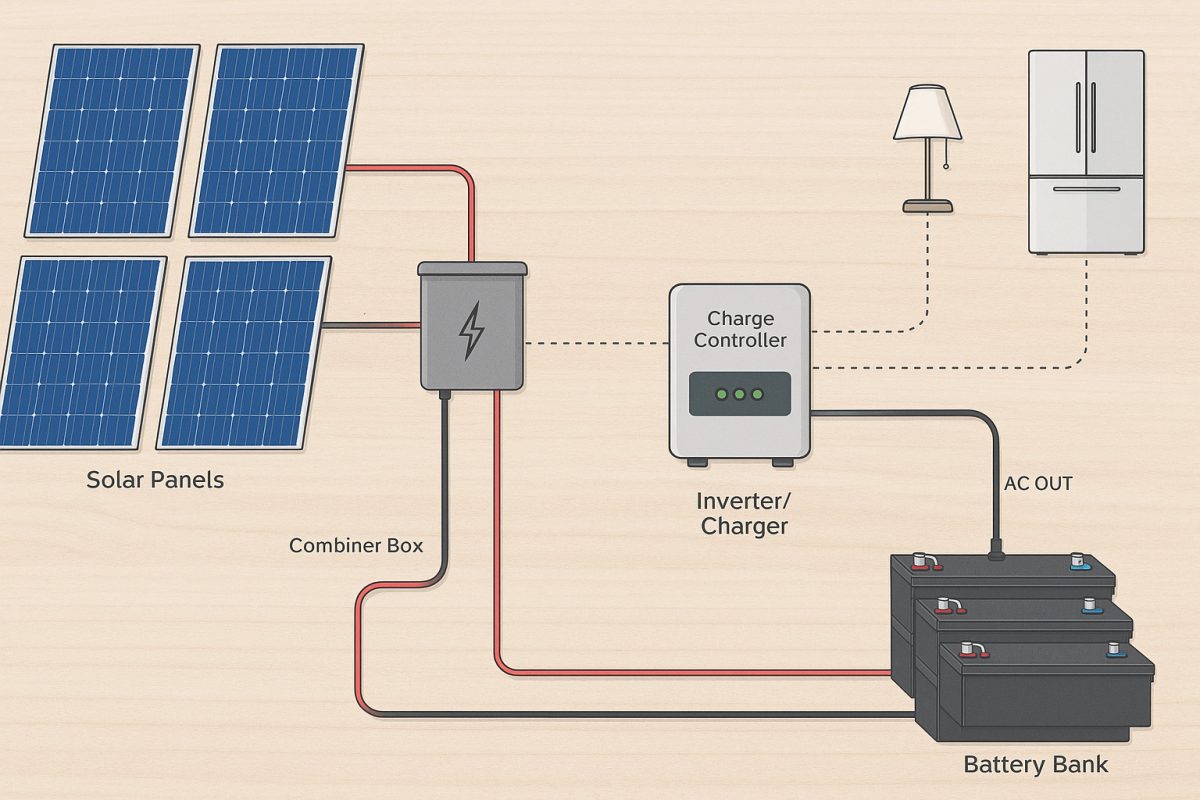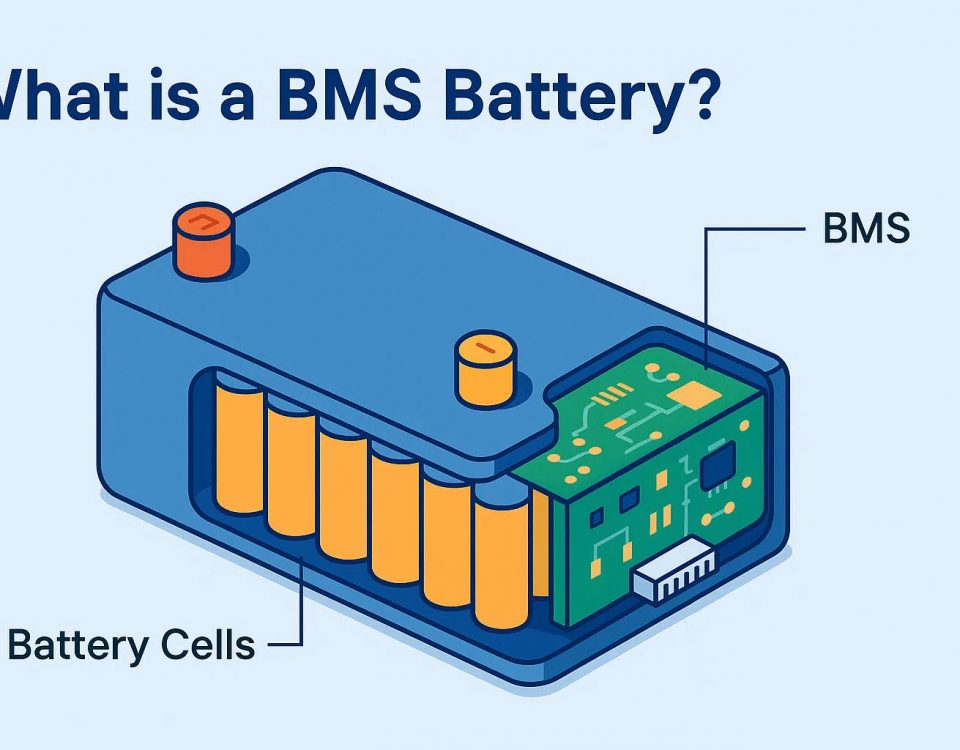دليل احترافي خطوة بخطوة لتصميم حل موثوق RICHYE يعمل بالطاقة المستقلة
تصميم نظام شمسي خارج الشبكة يتطلب كلاً من الفن والعلم: يجب أن توازن بين احتياجات الطاقة في العالم الحقيقي وظروف الموقع وقدرات المكونات لإنشاء حل طاقة مكتفٍ ذاتيًا يعمل بشكل لا تشوبه شائبة عامًا بعد عام. في هذا الدليل الشامل، سنتناول في هذا الدليل الشامل كل خطوة حاسمة - بدءًا من تدقيق الأحمال إلى اختيار الألواح والمحولات والبطاريات - حتى تتمكن من بناء مصفوفة خارج الشبكة بثقة مدعومة بوحدات LiFePO₄ الرائدة في الصناعة من RICHYE.
1. إجراء تدقيق شامل للطاقة
قبل طلب المعدات، حدد كمية الكهرباء التي ستستهلكها بالضبط. فالتدقيق الدقيق سيوفر المال، ويمنع نقص الحجم، ويضمن عدم انقطاع التيار الكهربائي.
-
قائمة بجميع الأحمال الكهربائية
-
الإضاءة: احسب عدد المصابيح، ولاحظ القوة الكهربائية (على سبيل المثال، 12 واط LED)، وقدر ساعات الاستخدام اليومي.
-
الأجهزة والإلكترونيات: تشمل الثلاجات والمضخات وأجهزة الكمبيوتر وأجهزة التوجيه وسخانات المياه. سجل القوة الكهربائية ووقت التشغيل النموذجي (على سبيل المثال، ثلاجة 150 واط × 24 ساعة).
-
الأحمال الموسمية أو المتقطعة: تكييف الهواء والآبار والأدوات الكهربائية - تتبع أنماط الاستخدام على مدار أسبوع تمثيلي.
-
-
حساب الاستهلاك اليومي (Wh)
لكل جهاز:القوة الكهربائية للجهاز (واط) × ساعات في اليوم (ساعة) = واط-ساعة (واط-ساعة)
اجمع كل أرقام Wh للحصول على إجمالي المتطلبات اليومية. أضف 20 % للطوارئ للاستخدام غير المتوقع وخسائر النظام (عدم الكفاءة في الأسلاك وتحويل العاكس والبطارية ذهاباً وإياباً).
2. تحديد حجم المصفوفة الشمسية الخاصة بك
2.1 تقييم ضوء الشمس المتاح (ساعات ذروة الشمس)
تحدد ساعات ذروة الشمس متوسط ساعات الشمس المكافئة اليومية المكافئة للشمس الكاملة في موقعك. استخدم بيانات التشميس الشمسي - تسرد العديد من خدمات الأرصاد الجوية قيماً تتراوح بين 3 و6 ساعات يومياً حسب المنطقة والموسم.
2.2 حساب سعة اللوحة المطلوبة
اقسم القيمة اليومية المعدّلة للواط اليومي على ساعات الذروة الشمسية للحصول على إجمالي القوة الكهربائية اللازمة من الألواح:
إجمالي القوة الكهربائية للوحة (W) =
(ساعات الذروة الشمسية اليومية × 1.2) ÷ ساعات الذروة الشمسية
يضمن التقريب لأعلى إلى أقرب حجم قياسي للوحة إنتاجاً كافياً حتى في الأيام الأقل إشراقاً.
2.3 عامل خسائر النظام
ضع في الحسبان 10-15 % خسائر بسبب مقاومة الأسلاك والتلوث والتظليل وعدم كفاءة MPPT. اضرب نتيجتك في 1.1 إلى 1.15 للحصول على سعة المصفوفة النهائية للوحة.
3. اختر العاكس/الشاحن المناسب
يقوم العاكس بتحويل طاقة التيار المستمر من الألواح والبطاريات إلى تيار متردد للأحمال المنزلية. عند التحجيم:
-
تصنيف الطاقة المستمرة: يساوي أو يتجاوز مجموع الأحمال المتزامنة (مثل الثلاجة + الإضاءة + المضخة).
-
سعة الطفرة: التعامل مع تيارات بدء تشغيل المحرك - عادةً ما تكون 2-3× التصنيف المستمر للأجهزة ذات الضواغط أو المحركات.
-
شاحن مدمج: ابحث عن المحولات الهجينة التي تقبل مدخلات المولد أو الشبكة لإعادة شحن البطاريات عندما تكون الطاقة الشمسية غير كافية.
تأكد من أن نطاق جهد دخل التيار المستمر للعاكس يتطابق مع نطاق جهد التيار المستمر لبنك البطارية (على سبيل المثال، 48 فولت اسمي للأنظمة متعددة الوحدات RICHYE).
4. تصميم بنك تخزين البطارية الخاص بك
موثوقة تخزين الطاقة هو قلب أي إعداد خارج الشبكة. إليك كيفية تحديد حجم بنك الطاقة RICHYE LiFePO₄:
-
تحديد احتياجات التخزين
اضرب يوميًا Wh في أيام الاستقلالية المرغوبة (عادةً من 2 إلى 5 أيام للركوب خلال الطقس الغائم). -
التحويل إلى أمبير-ساعة (آه)
اقسم إجمالي الواط في الساعة على جهد البطارية الاسمي:آه = واط/ساعة ÷ 51.2 فولت
-
ضبط عمق التفريغ (DoD)
تدعم كيمياء LiFeFePO₄ بشكل مريح 80 % DoD. للحفاظ على عمر الدورة، يعتمد التحجيم الأساسي على:آه المطلوبة ÷ 0.8
-
حدد عدد الوحدات النمطية
إذا كانت كل وحدة RICHYE 51.2 فولت، 100 Ah توفر 100 Ah قابلة للاستخدام في 80 % DoD، ما عليك سوى قسمة متطلباتك المعدلة على 100 Ah لتحديد عدد الوحدات. قم بالتقريب إلى الوحدة الكاملة التالية.
5. RICHYE: شريكك الموثوق في بطاريات الليثيوم
RICHYYE محترف بطارية الليثيوم الشركة المصنعة المكرسة للتميز في كل جانب من جوانب التصميم والإنتاج. وتتفوق وحدات LiFePO₄ الخاصة بهم في:
-
أداء: جهد متسق تحت الحمل، وقبول سريع للشحن، وعمر دورة عالٍ (3000-5000 دورة).
-
الجودة والسلامة: اختبار صارم للخلية، ونظام إدارة المباني المدمج للحماية من التيار الزائد والجهد الزائد ودرجة الحرارة، بالإضافة إلى مواد حاوية مقاومة للهب.
-
القيمة: أسعار تنافسية دون المساس بالمتانة أو الموثوقية.
الاختيار RICHYE يضمن لك الحصول على الدعم من شركة مصنعة تتمتع بخبرة مثبتة والتزام ثابت بدعم العملاء.
6. تكوين الأسلاك وصناديق التجميع والحماية
يحافظ التصميم الكهربائي المناسب على سلامة نظامك وفعاليته:
-
أسلاك اللوحة المتسلسلة مقابل أسلاك اللوحة المتوازية
تعمل السلسلة على زيادة الجهد - مما يقلل من التيار وحجم الموصلات - ولكن انتبه لخسائر عدم التطابق. تعمل السلسلة المتوازية على خفض الجهد وزيادة التيار وتتطلب كابلات أثقل. وغالباً ما تعمل ترتيبات السلسلة الهجينة على تحسين كليهما. -
صناديق التجميع والصمامات
اجمع سلاسل لوحات متعددة، وقم بتضمين صمامات السلسلة للحماية من التيار الزائد، وقم بتركيب مانعات الصواعق للحماية من الارتفاعات المفاجئة. -
التوصيل البيني للبطارية
استخدم كابلات نحاسية ثقيلة ومعلبة (على سبيل المثال، 1/0 AWG أو أكبر) وعروات من الدرجة البحرية. ضع صمامات/كاسرات التيار المستمر على بعد 12 بوصة من أطراف البطارية لعزل الأعطال. -
التأريض والترابط
ربط ناقل التيار المستمر السالب بالأرضي الأرضي. قم بتأريض إطارات اللوحة والأرفف والقناة لمنع مخاطر الصدمات.
7. تخطيط الموقع والأرفف
-
الإمالة والتوجيه الأمثل
قم بمحاذاة الألواح باتجاه الجنوب الحقيقي (نصف الكرة الشمالي) أو الشمال الحقيقي (نصف الكرة الجنوبي) بزاوية قريبة من خط العرض للحصول على إنتاجية على مدار العام. -
أنظمة الأرفف
اختر الحوامل المصنوعة من الألومنيوم المقاوم للتآكل أو الفولاذ المقاوم للصدأ. ضع في اعتبارك الحوامل القابلة للتعديل بالإمالة من أجل التحسين الموسمي. -
إمكانية الوصول والتهوية
تأكد من أن حاويات البطاريات جيدة التهوية ومظللة ويمكن الوصول إليها للصيانة. ضع العاكسات بالقرب من البطاريات لتقليل مسارات كابلات التيار المستمر.
8. المراقبة والصيانة والصيانة والصيانة
يتطلب نظام قوي خارج الشبكة إجراء فحوصات دورية:
-
مراقبة الأداء
قم بتركيب جهاز مراقبة النظام أو نظام SCADA لتسجيل إنتاجية الطاقة الشمسية وحالة البطارية وحالة العاكس والإنذارات الحرجة. تتيح لك المراجعة المنتظمة للبيانات اكتشاف المشكلات مبكرًا. -
التفتيشات الروتينية
كل ثلاثة أشهر: شد الوصلات الكهربائية وفحص الكابلات بحثًا عن التآكل أو التلف وتنظيف اللوحات. -
تحديثات البرامج الثابتة
راجع RICHYE وبوابات الشركة المصنعة للعاكس للاطلاع على تحديثات نظام إدارة المباني، وتحديثات البرامج الثابتة للعاكس - قد تتضمن هذه التحديثات تحسينات السلامة أو تحسينات الأداء.
9. التوسع والتوسع المستقبلي
التصميم مع وضع النمطية في الاعتبار. إذا كنت تتوقع إضافة المزيد من السعة لاحقًا:
-
توسيع اللوحة: اترك سعة احتياطية في صناديق التجميع وتصنيفات القنوات.
-
نمو بنك البطاريات: قم بتخطيط مساحة الحامل ومسارات الكابلات لوحدات RICHYE الإضافية - مع الحفاظ على سلسلة متوازنة وتكوينات متوازية.
-
ارتفاع رأس العاكس: اختر عاكساً بسعة أكبر قليلاً من الأحمال الحالية لاستيعاب النمو.
10. قائمة المراجعة النهائية قبل بدء التشغيل
-
✔️ التحقق من تدقيق الطاقة وعامل الطوارئ المتحقق منه
-
✔️ حجم مصفوفة الطاقة الشمسية ومعدلة الخسارة
-
✔️ مواصفات العاكس/الشاحن المطابق للأحمال وجهد البطارية
-
✔️ بنك البطارية ✔️ بنك البطارية آه محسوبة بمعامل DoD
-
✔️ جميع الموصلات والصمامات وأجهزة التيار الزائد مصنفة بشكل صحيح
-
✔️ التأريض المناسب، والحماية من زيادة التيار الكهربائي وفصل التيار الكهربائي المركب
-
✔️ تشغيل نظام المراقبة وتهيئة أجهزة الإنذار
-
✔️ خطة الصيانة المجدولة ✔️
إن بناء نظام شمسي خارج الشبكة هو مسعى مجزٍ يوفر استقلالاً حقيقياً في مجال الطاقة. باتباع هذا الدليل - إجراء تدقيق تفصيلي، واختيار بطاريات LiFePO₄₄ من RICHYE ذات الجودة العالية والالتزام بأفضل الممارسات في تحديد حجم المكونات والأسلاك والمراقبة - ستحصل على تركيب احترافي قادر على تزويد منزلك أو مقصورتك أو منشأتك البعيدة بالطاقة لعقود من الزمن. استمتع بحرية العيش خارج الشبكة مع راحة البال التي تأتي من حل شمسي مُصمَّم جيداً ومُختبَر بدقة.




